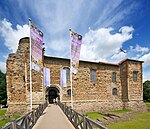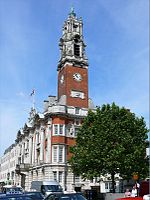St Helen's Chapel, Colchester
Church buildings converted to a different denominationFormer Church of England church buildingsGreek Orthodox Church of AntiochGreek Orthodox churches in the United Kingdom

St Helen's Chapel is an Eastern Orthodox church in Colchester, Essex, under the jurisdiction of the Antiochian Orthodox Christian Archdiocese of the British Isles and Ireland, headed by Metropolitan Silouan Oner.
Excerpt from the Wikipedia article St Helen's Chapel, Colchester (License: CC BY-SA 3.0, Authors, Images).St Helen's Chapel, Colchester
St. Helens Lane, Colchester
Geographical coordinates (GPS) Address Nearby Places Show on map
Geographical coordinates (GPS)
| Latitude | Longitude |
|---|---|
| N 51.891 ° | E 0.901 ° |
Address
St. Helens Lane
St. Helens Lane
CO1 1TY Colchester
England, United Kingdom
Open on Google Maps











